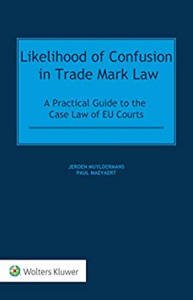
Jeroen Muyldermans and Paul Maeyaert, both experienced IP litigators at the renowned Belgian law firm Altius, have undertaken the humungous task of compiling, analysing, structuring and presenting the case law deriving from the General Court and Court of Justice in Luxembourg as well as the Boards of Appeal at the EUIPO on the topic of likelihood of confusion in trade mark law – which makes out the large majority of those decisions. The result is a book of just over 260 pages, which is easy to read yet surprisingly complete, and which can be used by both seasoned practitioners for refreshment and guidance, and newbies for getting an excellent overview over all the various issues to think about.
The book addresses the issue of likelihood of confusion from all angles, i.e. opposition and cancellation as well as infringement scenarios. Given the sheer quantity of decisions coming out of Alicante and Luxembourg on EUIPO proceedings, it is understandable if the focus sometimes shifts towards the opposition scenario.
Starting with a brief introduction to the EU trade mark system, including a helpful overview over the procedures before the EUIPO, the book continues with three chapters that address the general principles applying to the confusion test, the relevant public, and the constituent criteria of the confusion test. This latter chapter (Chapter 4) is the heart and soul of the book in that it presents and analyses the case law relating to the similarity of goods, the similarity of signs (with helpful colour illustrations!), and the global assessment of all relevant factors. Chapters 5 to 7, finally, address the well-known mark under Art. 6bis Paris Convention, the impact of consent and coexistence of trade marks on trade mark proceedings and likelihood of confusion, and the unitary character of court orders under the EU trade mark law.
Along this extensive journey through EU trade mark law, the authors also address well-known conundrums and open questions. Not all can be mentioned here, but to illustrate the breadth and depth of the book under review, we will pick out three: (1) the difference between co-branding and the usurpation of trade marks, (2) pre- and post-sale confusion in opposition and infringement scenarios, and (3) the fact that the reputation of the junior mark is not considered relevant to likelihood of confusion (at least not in opposition), but that this can be seen differently where the junior mark is a well-known person or name, based on conceptual differences between the marks (Becker vs. Barbara Becker; Massi vs. Messi).
As mentioned, a full chapter is dedicated to the assessment of the relevant public. While done primarily with a view to opposition proceedings, this highlights the importance of this step in the analysis of any trade mark case, as trade marks are not perceived in the abstract, but in the context of real-life markets. The identification of the relevant public, in particular from a linguistic view, plays a special role in EU trade mark cases involving either national or EU trade marks, and the particular attention paid to this is therefore fully justified.
The book does not pretend to be a scholarly treatise but a practical guide and does a very good job trying to conceptualise and structure the sometimes rather diverse, not to say erratic, case law of the EUIPO Boards of Appeal and the courts in Luxembourg. This approach justifies the absence of literature references. It also explains why the authors do not set out to put their own view or criticism of that case law in the centre but to provide a guide for living with and applying the case law.
The book was published on 15 October 2019 and already now there are a number of new decisions from Luxembourg that would warrant an update. That is life: if you write a good law book, you’re not done with one edition but are caught. As such, Jeroen and Paul, we will all hope for further editions to come. Perhaps you could contemplate adding an alphabetical index and a case list next time, as that would make the book even easier to use. Already now, it is highly recommended for lawyers, judges and examiners alike – as well as for students familiarising themselves with the practical aspects of trade mark law.
_____________________________
To make sure you do not miss out on regular updates from the Kluwer Trademark Blog, please subscribe here.


